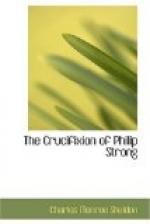“Why, he has been sexton of Calvary Church for ten years,” said another, an older member of the committee, Deacon Stearns by name. “He has been an honest, capable man. I never heard any complaint of him. He has always minded his own business. However, I don’t know how the church will take it to consider him as an applicant for membership.”
“Why, brethren, how can it take it in any except the Christian way?” said Philip, eagerly. “Here is a man who gives evidence of being born again. He cannot be present to-night when the other applicants come in later, owing to work he must do, but I can say for him that he gave all evidence of a most sincere and thorough conversion; he wishes to be baptized; he wants to unite with the church. He is of more than average intelligence. He is not a person to thrust himself into places where people do not wish him—a temperate, industrious, modest, quiet workman, a Christian believer asking us to receive him at the communion table of our Lord. There is no church for his own people here. On what possible pretext can the church refuse to admit him?”
“You do not know some of the members of Calvary Church, Mr. Strong, if you ask such a question. There is a very strong prejudice against the negro in many families. This prejudice is especially strong just at this time, owing to several acts of depredation committed by the negroes living down near the railroad tracks. I don’t believe it would be wise to present this name just now.” Deacon Stearns appeared to speak for the committee, all of whom murmured assent in one form or another.
“And yet,” said Philip, roused to a sudden heat of indignation; “and yet what is Calvary Church doing to help to make those men down by the railroad tracks any better? Are we concerned about them at all except when our coal or wood or clothing are stolen, or some one is held up down there? And when one of them knocks at the door of the church, can we calmly and coldly shut it in his face, simply because God made it a different color from ours?” Philip stopped and then finished by saying very quietly: “Brethren, do you think Christ would receive this man into the church?”
There was no reply for a moment. Then Deacon Stearns answered: “Brother Strong, we have to deal with humanity as it is. You cannot make people all over. This prejudice exists and sometimes we may have to respect it in order to avoid greater trouble. I know families in the church who will certainly withdraw if the sexton is voted in as a member. And still,” said the old deacon, with a sigh, “I believe Christ would receive him into His Church.”
Before much more could be said, the different applicants came, and as the custom was, after a brief talk with them about their purpose in uniting with the church, and their discipleship, they withdrew and the committee formally acted on the names for presentation to the church. The name of Henry Roland, the sexton, was finally reported unfavorably, three of the committee voting against it, Deacon Stearns at last voting with the minister to present the sexton’s name with the others.




